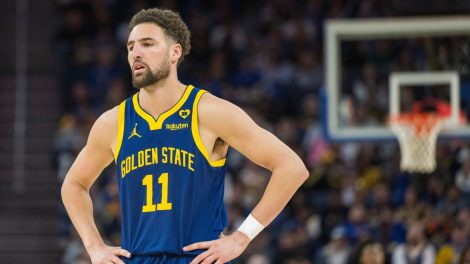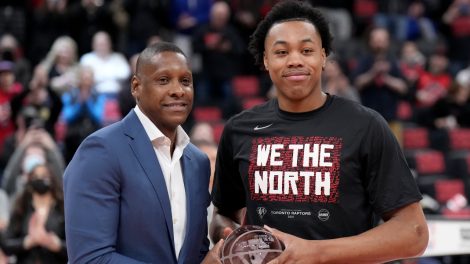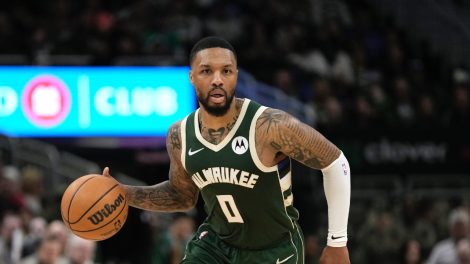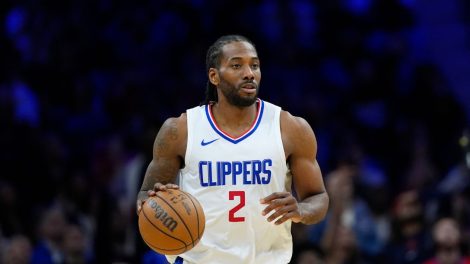Which Raptors made the grade this season and who needs to spend time in summer school? Sportsnet.ca’s Holly Mackenzie passes out the grades on Toronto’s campaign.
Quincy Acy
Season totals: 27 games, 4.0 ppg, 2.4 rpg, 10.9 mpg
While Quincy Acy hasn’t played a huge role for the Raptors this season, there wasn’t much from a rookie picked in the second round of the 2012 draft. Acy made the most of his opportunities, both with the team and during two stints in the D-League. He always played full-out, brought intensity (picking up five technicals on the season, two of which were rescinded), and showed he’s more than just a practice player. A solid first-year effort.
Final Grade: B
Alan Anderson
Season totals: 63 games, 10.7 ppg, 2.2 rpg, 1.6 apg, 28.7 mpg.
Alan Anderson played an important role for the Raptors during the first half of the season. The problem: It was a part that was too big for a bit player to fill. Anderson showed this season that he belongs in the NBA. He showed he can score — sometimes surprising his opponents — and he provided a toughness on the defensive end that the team needed. He just didn’t fit with what the team needed as the season wore on.
Final Grade: C
Andrea Bargnani
Season totals: 35 games, 12.7 ppg, 3.7 rpg, 28.7 mpg.
What a nightmare season. Start to finish, this was bad. From the disastrous start to the injuries to the boos from the ACC crowd, never has the relationship between Andrea Bargnani and Raptors fans been so contentious. There’s no need to go into stats here, this is a season to forget.
Final Grade: D
DeMar DeRozan
Season totals: 80 games, 17.9 ppg, 4.0 rpg, 2.5 apg, 37.0 mpg.
Yes, his PER is identical to last season. Yes, the three-point shot still needs to come along. Yes, the rebounding numbers went down as the season went on. Still, DeMar DeRozan inked a contract extension on opening night and he hasn’t looked back. Playing in all 82 games this season, he averaged a career-high 18 points per game, showed improved playmaking abilities and, perhaps most importantly, a better understanding of the game.
Final Grade: B
Landry Fields
Season totals: 49 games, 4.7 ppg, 4.0 rpg, 20.4 mpg.
This is a grade that is largely dependant upon the elbow injury that required surgery in November. After struggling greatly with his shot (and just the ability to catch the ball) through preseason, Landry Fields underwent surgery that has had him working to rediscover his shooting touch all season long. Shuffled in and out of the lineup, Fields showed glimpses of what he can do — moving without the ball, cutting to the basket, rebounding and finding open teammates — but wasn’t able to contribute significantly in his first year as a Raptor.
Final Grade: D
Rudy Gay
Season totals: 31 games, 19.4 ppg, 6.4 rpg, 2.8 apg, 35.3 mpg.
It’s hard to grade a player on 33 games. Since the Raptors traded for Rudy Gay at the end of January, he has been essentially the same player that he was through 42 games in Memphis this season. He has shot the ball often, but not well. He averaged as many turnovers as he did assists. He led the team in field goal attempts. The numbers don’t look great, but they also are not shocking. Gay came to the Raptors to a player who had been through the process of going from out of the playoffs to competing in them. Despite his struggles, he has given something that the team hasn’t had in a while: the sometimes over-the-top confidence often required to get to the next level.
Final Grade: C-
Amir Johnson
Season totals: 79 games, 10.1 ppg, 7.6 rpg, 1.5 apg, 28.7 mpg.
Was there really any doubt as to who would earn the highest grade in this Raptors class? Amir Johnson was, without a doubt, the team’s most valuable player this season. Somehow missing just one game on the year despite countless ankle sprains and enough therapy tape to make you cry, Johnson put in his best year as a pro, averaging 10 points and 7.6 rebounds per game. He shot 55 per cent from the floor. He averaged a block-and-a-half each night. He was the one the team looked to when they needed energy, effort and professionalism. Each night that he laced up his shoes, Toronto fans got every bit of Johnson’s heart. His opponents got a surprise when they realized how the hard work has paid off and turned Johnson into one of the most valuable rotation guys in the league.
Final Grade: A
Linas Kleiza
2012-13 numbers: 20 games, 7.4 ppg, 2.6 rpg, 18.8 mpg.
Playing in just 20 games this season, Linas Kleiza rehabbed a knee injury and struggled. Shooting a career-worst 33 per cent from the floor, Kleiza wasn’t just inefficient when he was on the floor, he was ineffective. It’s hard to give a failing grade to a guy that obviously wasn’t 100 per cent. Dodging and denying rumours out of Lithuania that his career was in jeopardy, Kleiza said he felt better than ever. While it is certainly hoped that this is the case, Kleiza never got to prove it on the court this season.
Final Grade: D
Kyle Lowry
2012-13 numbers: 66 games, 11.6 ppg, 6.3 apg, 4.8 rpg, 29.9 mpg.
When Kyle Lowry was traded to the Toronto Raptors, everyone was smiling. The keys to the franchise were handed to him in his introductory press conference, he seemed to be the type of player who would fit perfectly into Dwane Casey’s system and be embraced by the Toronto fans for his hard-nosed play. Then the season happened. Starting the year off brilliantly, Lowry was soon plagued with injury woes, missed time, lost his starting spot to Jose Calderon, and struggled to figure out the point guard his team wanted him to be. Along the way, there was a trade to bring in close friend Gay and send out Calderon to give him the starter’s role again, but he never fit into Casey’s system as expected. He also flip-flopped between playing his game and a more passive, watered-down version of his game as he tried to fit into a hybrid of what Calderon was and who he wanted to be. To Lowry’s credit, the final few weeks of the season he showed what he can do when comfortable with his teammates and when he is given trust to make the play calls.
Final Grade: C-
John Lucas
2012-13 numbers: 61 games, 5.2 ppg, 1.6 apg, 12.8 mpg.
John Lucas was brought to the Raptors to bring a scoring boost off of the bench. After a brutal start to the season where he couldn’t throw the ball into the ocean, Lucas settled into his role and did what he was brought here to do. He wasn’t spectacular, nor underwhelming. He played his role on the floor and kept things together off of it.
Final Grade: C+
Mickael Pietrus
2012-13 numbers: 19 games, 5.3 ppg, 1.9 rpg, 20.3 mpg.
Mickael Pietrus came to the Raptors when they were injury-depleted and it was believed he could provide a boost that Dominic McGuire could not. Playing in just 19 games, Pietrus became more of a presence in the locker room than a player on the court as the season wore on. To his credit, he handled things well, kept the mood light and was often seen pulling younger players aside and giving them pointers despite not contributing through his own play.
Final Grade: D
Terrence Ross
2012-13 numbers: 72 games, 6.4 ppg, 2.6 rpg, 18.8 mpg.
Rookie seasons are about making mistakes and growing from them. By this measurement, Ross had an average year. The eighth pick in the draft last season, Ross certainly made his share of mistakes this year (especially on the defensive end of the floor), but he also showed flashes of why the team used a lottery pick on him a year ago. The ability to hit the three-point shot while also using his athleticism to get by defenders and slash to the hoop will always give people pause and make them take a second look. While most will point to the Dunk Contest as the season highlight for Ross, there was a game against the Orlando Magic in January where Ross had everything going and it was like a sneak peek of the trouble he can cause if he keeps working.
Final Grade: C-
Sebastian Telfair
2012-13 numbers: 13 games, 0 starts, 4.3 ppg, 3.0 apg, 14.2 mpg.
How do you grade a player who played in just 13 (MAYBE 14 IF PLAYS TONIGHT) games for the team after being traded to the Raptors on trade deadline day? You don’t, really. While Telfair showed up, suited up, and did his job whenever he was on the floor, it’s impossible to grade him anything other than a standard C.
Final Grade: C
Jonas Valanciunas
2012-13 numbers: 60 games, 8.7 ppg, 6.0 rpg, 1.23 bpg, 23.7 mpg
If we use the same measurement that we used for fellow rookie Terrence Ross, Jonas Valanciunas receives the second-highest grade on the team. Sure, there were plenty of mistakes and miscues, again, especially on the defensive end, but Valanciunas put in a solid rookie campaign. While he was slowed by the broken finger that took him out of action for six weeks, he bounced back in a big way and finished the season strong. Showing an increased understanding game by game, Valanciunas put in work to learn the nuances of the NBA while studying his opponents so he didn’t make the same mistakes twice. As his confidence grew, so did his teammates’ trust in him and the increased opportunity resulted in him winning the Eastern Conference Rookie of the Month award for March. The award and the finish to the season is just a look at what Raptors fans will see more of in the future from Valanciunas. Still just 20 years old, the big man made huge strides in his first season, showing a toughness and competitive fire that has been needed.
Final Grade: B+
Dwane Casey
It’s hard to grade a coach on a season that feels like there were three separate campaigns rolled into one, but, as Dwane Casey has said himself, how the team does will fall on his shoulders. Despite that brutal 4-19 start, somehow the team finished the year within a couple of wins of most preseason predictions (Hey, John Hollinger. Who the hell are you, anyway?). Amid the struggles, and some rotations that require head scratching, Casey managed to keep his players engaged and didn’t lose their ear. Looking back on the season, one has to wonder what could have been had Casey and Lowry found a middle ground earlier on.
Final Grade: D
Bryan Colangelo
It’s hard to fault Bryan Colangelo for thinking Kyle Lowry could be the missing piece the team needed. When the deal was made, it was unanimously supported. Colangelo gets a pass there. Looking at the rest of the season though, and the players, coaching staff and support staff assembled together, it’s hard to give Colangelo anything other than a D- on the year. Through all of the struggles, there have been moves to try to fix things, but those moves have each brought with them more struggles and issues to be addressed. While players and coaches generally shoulder the bulk of the blame that comes from underachieving, the right team has to be assembled for success to be reached. What’s more, there needs to be complete trust between front office and coaching staff. At various times during the season, blame was swiftly placed upon Casey’s shoulders. It’s time for that blame to be evenly distributed amongst those calling the shots.
Final Grade: D-










